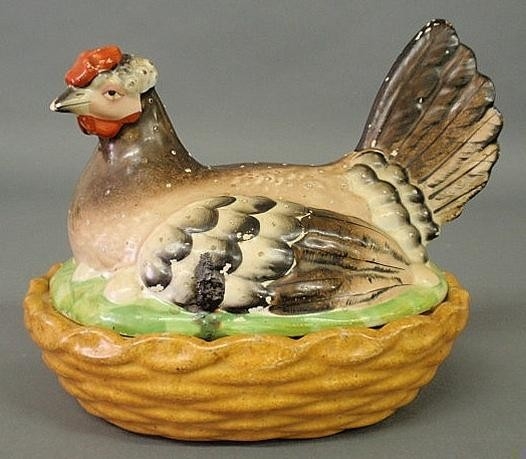Some of the most ubiquitous antiques are hen-on-nest covered dishes. They’re so common that they’ve acquired a sort of shorthand in the antiques business or become somewhat of a joke, but in reality, they’ve got an interesting history. While people may not realize it, the form – a laying hen cozy in her nest – originated in China several centuries ago and found popularity in Europe in the late 18th century. According to some historians, they were originally used, depending on their size, to serve boiled or scrambled eggs or butter.
Of course, with Europe setting the fashions at the time, hens on nests gained popularity in the United States as well. Exported by places like Staffordshire (where the classic example pictured above was created), they remained fairly expensive until the middle of the 19th century when the technique of pressing glass was developed. Pressed glass made producing hens on nests much more affordable, and this, coupled with the Victorians’ love of animal forms and figures, made them boom in popularity. They began to appear in all different shades of glass and with a variety of finishes. (Hens on nests were such a popular motif that they also appear in candy molds, cast-iron banks, and marble sulphides.) Then around the turn of the century, manufacturers began to cash in on the popularity of the form, packaging condiments like mustard in hen-on-nest dishes to sell. This resulted in examples from many major American glass manufacturers at the time, companies like Fenton and Greentown. Today, collectors can chose hens on nests in carnival glass or milk glass, majolica or Staffordshire, and while the prices they bring won’t always feather your nest, they can certainly make it more colorful!
-Hollie Davis, Senior Editor, p4A.com





No comments
Comments feed for this article
Trackback link: https://www.prices4antiques.com/blog/hen-on-nest-covered-dishes/trackback/